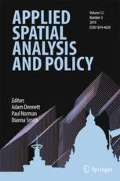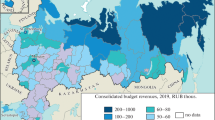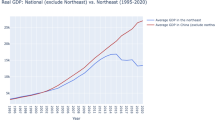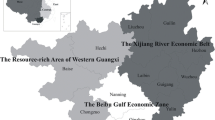Abstract
Although many studies have been conducted on regional inequality, no consistent findings can be produced in terms of the temporal trends and mechanisms underlying regional inequality until now. It is widely acknowledged that the utilization of different data sources, time periods and methodologies gives rise to different measurements of regional inequality. This study aims to shed new light on this issue from the perspective of administrative boundary changes in China. Since the reform and open-door policy in 1978, administrative divisions in China have frequently been adjusted as part of a strategy of the State to promote rapid economic development. This strategy poses a great challenge to the study of temporal trends as well as the causal mechanisms for regional inequality, which has been rarely studied. Taking the Chinese province of Guangdong as an example, this paper adopts a multi-scale decomposition method to demonstrate that administrative boundary changes have a significant impact on the measurement of regional inequality. By excluding administrative boundary changes, previous studies often portrayed a misleading picture of the divergence or convergence of regional inequality. Drawing on a multi-scale and multi-mechanism framework, this paper employs a spatial regression model to investigate the impact of administrative boundary changes on extracting mechanisms of regional inequality. On the one hand, administrative restructuring alters the intensity of spatial dependence of regional development. On the other hand, different combinations of significant driving factors vary under different administrative divisions. Therefore, the consideration of administrative boundary changes would enhance a fuller understanding of regional inequality in China.




Similar content being viewed by others
Notes
For details of China’s hierarchical administrative/spatial system see Zhang & Wu (2006, p.7). A province in China, in the simplest case, is formed by a number of prefecture-level cities. An prefecture-level city can be formed by urban districts (e.g. Shenzhen), or with one or more county(ies) or/and county-level city(ies). Because of data availability, the multiple urban districts within each prefecture-level city is analyzed, and referred to, in this paper as one urban district.
The authors ran a multivariate regression model to identify the most importance factor for use in our analysis among the followings: topography (represented by three variables: average elevation, average slope, and the percentage of area within a spatial unit with the slope smaller than 10 %), the ability to participate in international trade (approximated by the distance from each spatial unit to the coast), transportation cost (represented by the average transportation cost in hours from each spatial unit to others) and supply of natural resource (quantified by forest coverage rate) is determined by running a multivariate regression model. Average elevation had stood out to be our choice.
References
Alonso, W. (1980). Five bell shapes in development. Papers in Regional Science, 45(1), 5–16.
Amos Jr., O. M. (1990). Growth pole cycles. Review of Regional Studies, 20(1), 37–48.
Anselin, L. (Ed.). (2001). Spatial econometrics in B. Baltagi (Ed.), A companion to theoretical econometrics. Oxford: Blackwell.
Anselin, L., & Florax, R. (Eds.) (1995). New directions in spatial econometrics. Berlin: Springer.
Anselin, L., Syabri, I., & Kho, Y. (2006). GeoDa: an introduction to spatial data analysis. Geographical analysis, 38(1), 5–22.
Bao, S., Chang, G. H., Sachs, J. D., & Woo, W. T. (2002). Geographic factors and China’s regional development under market reforms, 1978–1998. China Economic Review, 13(1), 89–111.
Barro, R., & Sala-i-Martin, X. (1995). Economic growth. New York: McGraw-Hill.
Benhabib, J., & Spiegel, M. M. (1994). The role of human capital in economic development evidence from aggregate cross-country data. Journal of Monetary Economics, 34(2), 143–173.
Briant, A., Combes, P.-P., & Lafourcade, M. (2010). Dots to boxes: Do the size and shape of spatial units jeopardize economic geography estimations? Journal of Urban Economics, 67(3), 287–302.
Bukenya, J. O., Gebremedhin, T. G., & Schaeffer, P. V. (2002). Income convergence: A case study of West Virginia counties. Research paper 2002–03. Alabama A&M University.
Butkiewicz, T., Meentemeyer, R. K., Shoemaker, D. A., Chang, R., Wartell, Z., & Ribarsky, W. (2010). Alleviating the Modifiable Areal Unit Problem within Probe-Based Geospatial Analyses. Computer Graphics Forum, 29(3), 923–932.
Chen, X. (1991). China’s city hierarchy, urban policy and spatial development in the 1980s. Urban Studies, 28(3), 341–367.
CSB (National Bureau of Statistics of China). (2011). China statistical yearbook, 2011. Beijing: Chinese Statistics Press.
CSB (National Bureau of Statistics of China). (2014). China statistical yearbook, 2014. Beijing: Chinese Statistics Press.
Démurger, S., Sachs, J. D., Woo, W. T., Bao, S., & Chang, G. (2002). The relative contributions of location and preferential policies in China’s regional development: being in the right place and having the right incentives. China Economic Review, 13(4), 444–465.
Fan, C. C., & Sun, M. (2008). Regional inequality in China, 1978–2006. Eurasian Geography and Economics, 49(1), 1–18.
Fleisher, B., Li, H., & Zhao, M. Q. (2010). Human capital, economic growth, and regional inequality in China. Journal of Development Economics, 92(2), 215–231.
Fotheringham, A. S., & Wong, D. W. (1991). The modifiable areal unit problem in multivariate statistical analysis. Environment and Planning A, 23(7), 1025–1044.
Friedmann, J. (1966). Regional development policy: a case study of Venezuela (Vol. 5). Cambridge: MIT press.
Gylfason, T. (2001). Natural resources, education, and economic development. European Economic Review, 45(4-6), 847–859.
Hirschman, A. O. (1958). The strategy of economic development (Vol. 58). New Haven: Yale University Press.
Kanbur, R., & Zhang, X. (1999). Which regional inequality? The evolution of rural–urban and inland–coastal inequality in China from 1983 to 1995. Journal of Comparative Economics, 27(4), 686–701.
LeSage, J. P. (1999). A spatial econometric examination of China’s economic growth. Geographic. Information Sciences, 5(2), 143–153.
LeSage, J., & Pace, R. K. (2009). Introduction to spatial econometrics. Boca Raton: CRC press.
Li, L. C. (1997). Provincial discretion and national power: investment policy in Guangdong and shanghai, 1978–93. The China Quarterly, 152, 778–804.
Li, C., & Gibson, J. (2013). Rising regional inequality in China: fact or artifact? World Development, 47, 16–29.
Li, Y., & Wei, Y. (2010). The spatial-temporal hierarchy of regional inequality of China. Applied Geography, 30(3), 303–316.
Liao, F. H. F., & Wei, Y. D. (2012). Dynamics, space, and regional inequality in provincial China: A case study of Guangdong province. Applied Geography, 35(1–2), 71–83.
Liao, F. H., & Wei, Y. D. (2015). Space, scale, and regional inequality in provincial China: A spatial filtering approach. Applied Geography, 61, 94–104.
Lin, G. C. (2009). Scaling-up regional development in globalizing China: local capital accumulation, land-centred politics, and reproduction of space. Regional studies, 43(3), 429–447.
Liu, J. (1996). Zhongguo xingzheng quhua de lilun yu shijian (Theory and Practice in Administrative Zoning in China). Shanghai: Huadong shifan daxue chubanshe (In Chinese).
Liu, H. (2006). Changing regional rural inequality in China 1980–2002. Area, 38(4), 377–389.
Lo, C. P. (1994). Economic reforms and socialist city structure: a case study of Guangzhou, China. Urban Geography, 15(2), 128–149.
Lu, L., & Wei, Y. D. (2007). Domesticating globalisation, new economic spaces and regional polarisation in Guangdong Province, China. Tijdschrift voor economische en sociale geografie, 98(2), 225–244.
Ma, L. J. (2002). Urban transformation in China, 1949-2000: a review and research agenda. Environment and Planning A, 34(9), 1545–1570.
Ma, L. J. (2005). Urban administrative restructuring, changing scale relations and local economic development in China. Political Geography, 24(4), 477–497.
Ma, L. J., & Cui, G. (1987). Administrative changes and urban population in China. Annals of the Association of American Geographers, 77(3), 373–395.
Oi, J. C. (1995). The role of the local state in China’s transitional economy. The China Quarterly, 144, 1132–1149.
Ou, X. J., & Zhao, Q. (2007). Quantitative analysis of factors of regional economic inequality in Jiangsu Province with regional separation index. Geographical Research, 26(4), 693–704 (In Chinese).
Park, A., Rozelle, S., Wong, C., & Ren, C. (1996). Distributional consequences of reforming local public finance in China. The China Quarterly, 147, 751–778.
Rey, S. J., & Janikas, M. V. (2005). Regional convergence, inequality, and space. Journal of Economic Geography, 5(2), 155–176.
Rey, S. J., & Montouri, B. D. (1999). US regional income convergence: a spatial econometric perspective. Regional studies, 33(2), 143–156.
Sachs, J. D., & Warner, A. M. (1997). Fundamental sources of long-run growth. The American Economic Review, 87(2), 184–188.
Sala-i-Martin, X. X. (1996). The classical approach to convergence analysis. The economic journal, 106(437), 1019–1036.
Shorrocks, A. F. (1984). Inequality decomposition by population subgroups. Econometrica, 52(6), 1369–1385.
Smith, N. (1984). Uneven development: nature, capital and the production of space. London: Blackwell.
Song, Y. (2013). Rising Chinese regional income inequality: the role of fiscal decentralization. China Economic Review, 27, 294–309.
Tsui, K.-y. (1996). Economic reform and interprovincial inequalities in China. Journal of Development Economics, 50(2), 353–368.
Tsui, K.-y. (1998). Trends and inequalities of rural welfare in China: evidence from rural households in Guangdong and Sichuan. Journal of Comparative Economics, 26(4), 783–804.
Wei, Y. D. (1999). Regional inequality in China. Progress in Human Geography, 23(1), 49–59.
Wei, Y. D. (2001). Decentralization, marketization, and globalization: the triple processes underlying regional development in China. Asian Geographer, 20(1–2), 7–23.
Wei, Y. D. (2002). Multiscale and multimechanisms of regional inequality in China: implications for regional policy. Journal of Contemporary China, 11(30), 109–124.
Wei, Y. D. (2015). Spatiality of regional inequality. Applied Geography, 61, 1–10.
Wei, Y. D., & Fan, C. C. (2000). Regional inequality in China: a case study of Jiangsu province. The Professional Geographer, 52(3), 455–469.
Wei, Y. D., & Kim, S. (2002). Widening inter-county inequality in Jiangsu province, China, 1950–95. Journal of Development Studies, 38(6), 142–164.
Wei, Y., & Ma, L. J. C. (1996). Changing patterns of spatial inequality in China, 1952–1990. Third World Planning Review, 18(2), 177.
Wei, Y. D., & Ye, X. (2004). Regional inequality in China: A case study of Zhejiang Province. Tijdschrift voor economische en sociale geografie, 95(1), 44–60.
Wei, Y. D., & Ye, X. (2009). Beyond convergence: space, scale, and regional inequality in China. Tijdschrift voor economische en sociale geografie, 100(1), 59–80.
Wei, K., Yao, S., & Liu, A. (2009). Foreign direct investment and regional inequality in China. Review of Development Economics, 13(4), 778–791.
Xu, J., & Yeh, A. G. O. (2003). Guangzhou. Cities, 20(5), 361–374.
Ye, X., & Dang, A. (2013). Spatial analysis and modeling of urban and regional development. Annals of GIS, 19(3), 129.
Ye, X., & Wei, Y. D. (2005). Geospatial analysis of regional development in China: the case of Zhejiang Province and the Wenzhou model. Eurasian Geography and Economics, 46(6), 445–464.
Yu, D. L. (2006). Spatially varying development mechanisms in the greater Beijing area: a geographically weighted regression investigation. The Annals of Regional Science, 40(1), 173–190.
Yu, H. (2011). Economic development and inequality in China: the case of Guangdong. New York: Routledge.
Yu, D. L., & Wei, Y. H. D. (2008). Spatial data analysis of regional development in Greater Beijing, China, in a GIS environment. Papers in Regional Science, 87(1), 97–117.
Zhang, J., & Wu, F. (2006). China’s changing economic governance: administrative annexation and the reorganization of local governments in the Yangtze River Delta. Regional studies, 40(1), 3–21.
Zhang, J., Shen, J., Huang, J., & Zhen, F. (2002). The administrative division and regional governance in urban agglomeration areas. City Planning Review, 26(9), 40–44.
Zhao, X. B., & Tong, S. (2000). Unequal economic development in China: spatial disparities and regional policy reconsideration, 1985–1995. Regional studies, 34(6), 549–561.
Author information
Authors and Affiliations
Corresponding author
Rights and permissions
About this article
Cite this article
He, S., Chung, C.K.L., Bayrak, M.M. et al. Administrative Boundary Changes and Regional Inequality in Provincial China. Appl. Spatial Analysis 11, 103–120 (2018). https://doi.org/10.1007/s12061-016-9203-5
Received:
Accepted:
Published:
Issue Date:
DOI: https://doi.org/10.1007/s12061-016-9203-5




